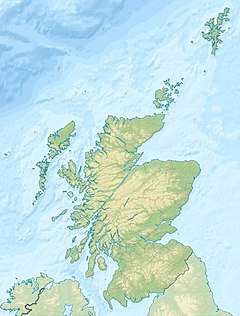Edinburgh's New Town

Edinburgh's New Town, viewed from Edinburgh Castle. Princes Street and the Princes Street Gardens are visible in the foreground.
|
|
| UNESCO World Heritage Site | |
|---|---|
| Location |
Edinburgh, Scotland |
| Coordinates | 55°57′22″N 3°11′56″W / 55.956247°N 3.198928°W |
| Criteria | ii, iv |
| Reference | 728 |
| Inscription | 1995 (19th Session) |
|
[]
|
|
The New Town is a central area of Edinburgh, the capital of Scotland. It is often considered to be a masterpiece of city planning and, together with the Old Town, was designated a UNESCO World Heritage Site in 1995. It was built in stages between 1767 and around 1850, and retains much of the original neo-classical and Georgian period architecture. Its most famous street is Princes Street, facing Edinburgh Castle and the Old Town across the geographical depression of the former Nor Loch.
The idea of a New Town was first suggested in the late 17th century when the Duke of Albany and York (later King James VII and II), when resident Royal Commissioner at Holyrood, encouraged the idea of having an extended regality to the north of the city and a North Bridge. He gave the city a grant:
That, when they should have occasion to enlarge their city by purchasing ground without the town, or to build bridges or arches for the accomplishing of the same, not only were the proprietors of such lands obliged to part with the same on reasonable terms, but when in possession thereof, they are to be erected into a regality in favour of the citizens.
It is possible that, with such patronage, the New Town may have been built many years earlier than it was but, in 1682, the Duke left the city and became King in 1685, only to lose the throne in 1688.
The decision to construct a New Town was taken by the city fathers, after overcrowding inside the Old Town city walls reached breaking point and to prevent an exodus of wealthy citizens from the city to London. The Age of Enlightenment had arrived in Edinburgh, and the outdated city fabric did not suit the professional and merchant classes who lived there. Lord Provost George Drummond succeeded in extending the boundary of the Royal Burgh to encompass the fields to the north of the Nor Loch, the heavily polluted body of water which occupied the valley immediately north of the city. A scheme to drain the Loch was put into action, although the process was not fully completed until 1817. Crossing points were built to access the new land; the North Bridge in 1772, and the Earthen Mound, which began as a tip for material excavated during construction of the New Town. The Mound, as it is known today, reached its present proportions in the 1830s.
...
Wikipedia

